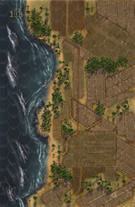|
Beaches of Guam Ancient Armor #1 |
||
|---|---|---|
| (Attacker) Japan | vs |
Guam
(Defender)
United States (Defender) |
| Formations Involved |
|---|

|
| Overall Rating, 2 votes |
|---|
|
3
|
| Scenario Rank: --- of 940 |
| Parent Game | Ancient Armor |
|---|---|
| Historicity | Alt-History |
| Date | 1941-12-08 |
| Start Time | 06:00 |
| Turn Count | 20 |
| Visibility | Day |
| Counters | 38 |
| Net Morale | 1 |
| Net Initiative | 2 |
| Maps | 2: 101, 83 |
| Layout Dimensions | 56 x 43 cm 22 x 17 in |
| Play Bounty | 168 |
| AAR Bounty | 165 |
| Total Plays | 2 |
| Total AARs | 2 |
| Battle Types |
|---|
| Amphibious Landing |
| Inflict Enemy Casualties |
| Conditions |
|---|
| Naval Bombardment |
| Randomly-drawn Aircraft |
| Scenario Requirements & Playability | |
|---|---|
| Ancient Armor | Base Game |
| Marianas 1944 | Maps + Counters |
| Saipan 1944 | Maps + Counters |
| Introduction |
|---|
|
The Japanese landings on Guam met with brief resistance from the Insular Guard (the territory’s equivalent of the National Guard) and the small garrison of Marines. The actual fighting lasted about an hour before Governor George McMillin ordered the troops to surrender. A stronger garrison might have forced the Japanese to conduct opposed landings. |
| Conclusion |
|---|
|
In the actual invasion of Guam, the Japanese landed without opposition. Japan’s “marines,” called “Special Naval Landings Forces,” did not have the same amphibious mission and training as the U.S. Marines. They might be better considered as “landing parties” – well-armed and trained - landing parties, but not intended to storm a defended beach. Unless the beach were defended. |
| AFV Rules Pertaining to this Scenario's Order of Battle |
|---|
|
| 1 Errata Item | |
|---|---|
| Scen 1 |
In this scenarios, the entrenchments and minefields should be setup four hexes or more east of the beach hexes. (JayTownsend
on 2021 Feb 12)
|
| Outmatched | ||||||||||||
|---|---|---|---|---|---|---|---|---|---|---|---|---|
On an early December morning in the summer of 1941-42, the quiet on the western beaches of Guam was broken by the sound of many Japanese Daihatsu landing vessels heading east toward the shore. The shore protection for the island came from the island’s only HMG unit along with a couple of infantry platoons that had entrenched just northeast of the main beach area. Further inland, there were minefields and another entrenched group of infantry. Further east, along the track, a lone American M1917 platoon stood ready to move from the village against any Japanese units attempting to skirt the minefields. Elements of the 2nd Maizuru Special Naval Landing Force (SNLF) established a beachhead on Dunggas Beach at 0630 hours with all units ashore. They surrounded the shore position and moved northeast attacking the shore entrenchment. By 0700 hour, the remaining Guamanian units from the shore position were retreating northeast, but the HMG platoon was cut off near the beach and destroyed at 0745. The Japanese then crossed the minefield and assaulting the remaining Guamanian entrenchment at the edge of the jungle. By 0830, the home-guard units retreated east from the entrenchment under heavy assault, and they were joined by an American M1917 armor platoon. By 0945, the last Guamanian infantry has been surrounded; at 1000, the lone M1917 platoon also surrendered, and the Guamanian Sergeant was sent fleeing for help. This 20-turn scenario supposes that a slightly larger force was present on Guam to oppose the Japanese landings there in 1941. The primary objectives involve either Japanese step loss or demoralization of Guamanian units. In addition to a manpower advantage, the Japanese also benefit from both airpower and OBA on every turn. The Japanese had the initiative on every turn, often with multiple activations, which helped in their pursuit of the Guamanian units. This is the one aspect of the scenario that is a bit gamey, since the Allies can get a draw by just having a single undemoralized unit survive. Thus, an Allied player could make it a chase-and-hide scenario. On the other hand, this could be deemed somewhat historical due to the fear of Japanese retaliation if they were caught. The Japanese caught a huge break early in the scenario when the first minefield they hit was a decoy. This opened a nice gap through the mines that they exploited to overwhelm the last entrenchment. It was a slow process as the outgunned Allies managed to hang on for a number of turns, but the end appeared inevitable. All fourteen Allied steps were lost against only two lost for the Japanese, resulting in a Japanese victory. |
||||||||||||
| 0 Comments |
| Ancient Armor, Scenario One: Beaches of Guam | ||||||||||||
|---|---|---|---|---|---|---|---|---|---|---|---|---|
Ancient Armor, Scenario One: Beaches of Guam A novelty scenario but the Guamanian/American player has little chance of winning this one with the victory condition as they are. I believe my similar scenario from Marianas: Scenario #11: Out of No Where, the victory conditions at least gives the Guamanian/American player a little chance. Not to compare. My game ended on turn 12 with a complete Japanese victory. The Guam Garrison lost 3 INF steps eliminated, 2 HMG steps eliminated, both M1917 tanks steps eliminated, both the American LT and the Guam Sergeant eliminated and the remaining 7 INF steps demoralized and running into the jungle hexes of map 83. The Japanese only had two demoralized SNLF steps and one Disrupted SNLF step. The M1917 is a cool tank counter but pretty useless, kind of like the Italian L3/33s. Wasn’t balanced but I liked playing the scenario as an exercise and getting to play with unique unit types. |
||||||||||||
| 0 Comments |

 AaGI010
AaGI010 















